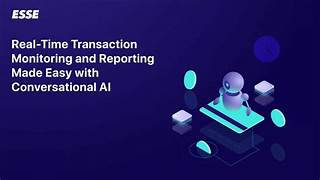Real-Time Transaction Monitoring with AI
The financial world today is more interconnected than ever, with millions of transactions occurring every second across various platforms and countries. These transactions encompass everything from online purchases to cross-border remittances, corporate deals, and high-frequency trading. Amid this immense volume, ensuring the safety, speed, and accuracy of transactions is a critical challenge for financial institutions. Real-time transaction monitoring, powered by artificial intelligence (AI), has emerged as a transformative solution to address this need.
This article explores the concept of real-time transaction monitoring with AI, its applications, benefits, challenges, and the future of this technology in the financial ecosystem.
Understanding Real-Time Transaction Monitoring
Real-time transaction monitoring involves tracking, analyzing, and assessing transactions as they occur, with the aim of detecting anomalies, fraudulent activities, or compliance violations. Traditional methods relied on rule-based systems and manual oversight, which were often slow, prone to errors, and incapable of handling the sheer volume of modern transactions.
AI revolutionizes transaction monitoring by leveraging machine learning (ML), natural language processing (NLP), and advanced analytics to provide instant insights and actions. AI-powered systems can process and analyze vast datasets, recognize complex patterns, and adapt to evolving risks, ensuring a robust monitoring framework.
How AI Enhances Real-Time Monitoring
1. Fraud Detection and Prevention
AI systems excel at identifying suspicious transactions by analyzing patterns, behaviors, and historical data. Machine learning algorithms detect anomalies that deviate from typical behavior, such as unusually large transfers, transactions from unfamiliar locations, or multiple attempts within a short period. These insights help prevent fraudulent activities like phishing, account takeovers, and money laundering.
2. Regulatory Compliance
Compliance with anti-money laundering (AML) and know-your-customer (KYC) regulations is a major concern for financial institutions. AI automates the identification of compliance breaches by cross-referencing transactions with global sanctions lists, politically exposed persons (PEP) databases, and other regulatory frameworks. This reduces the risk of fines and reputational damage.
3. Risk Assessment
AI-powered systems continuously evaluate transaction risks based on predefined parameters such as transaction amount, geographical location, and customer history. They assign risk scores in real-time, allowing financial institutions to prioritize high-risk transactions for further investigation.
4. Real-Time Alerts
When anomalies or risks are detected, AI systems trigger instant alerts to relevant teams. These alerts are accompanied by detailed explanations, enabling swift action to block or investigate transactions.
5. Pattern Recognition
AI identifies trends and patterns in transaction data that may indicate emerging threats or opportunities. For example, it can detect coordinated fraudulent activities across multiple accounts or predict seasonal spikes in certain transaction types.
6. Adaptive Learning
AI systems are dynamic and continuously improve through adaptive learning. They update their models based on new data, emerging threats, and feedback from investigators, ensuring they stay effective in a rapidly changing environment.
Applications of Real-Time Transaction Monitoring with AI
1. Retail Banking
AI monitors customer transactions to detect potential fraud, such as unauthorized credit card use or suspicious account activity. This ensures customer trust and reduces financial losses.
2. E-Commerce
Online platforms benefit from AI-driven monitoring to prevent payment fraud, chargebacks, and unauthorized access to payment gateways.
3. Cryptocurrency Exchanges
Given the volatility and anonymity associated with cryptocurrencies, AI helps detect irregular trading patterns, large transfers, and potential money laundering activities.
4. Cross-Border Payments
AI ensures the security and compliance of international transactions by monitoring for signs of trade-based money laundering or sanctions violations.
5. Insurance Claims
In the insurance sector, AI identifies fraudulent claims by analyzing transaction history, customer data, and claim patterns.
6. Stock Trading
High-frequency trading platforms rely on AI to monitor trades in real time, ensuring market integrity and detecting potential manipulative practices.
Benefits of AI-Driven Real-Time Monitoring
1. Enhanced Speed and Accuracy
AI processes vast amounts of data in milliseconds, ensuring that no transaction goes unchecked. Its accuracy surpasses human capabilities, reducing false positives and missed risks.
2. Proactive Fraud Prevention
Unlike traditional systems that often detect fraud after it occurs, AI acts proactively by identifying risks before transactions are completed.
3. Cost Efficiency
Automating transaction monitoring reduces the need for extensive manual oversight, saving financial institutions significant time and resources.
4. Improved Customer Experience
Real-time monitoring minimizes disruptions for legitimate customers by quickly approving transactions while flagging only suspicious ones for review.
5. Scalability
AI systems handle increasing transaction volumes effortlessly, making them ideal for global financial institutions and growing businesses.
6. Regulatory Confidence
By ensuring compliance with ever-changing regulations, AI helps institutions maintain their reputation and avoid legal penalties.
Challenges in Implementing AI for Real-Time Monitoring
1. Data Quality and Integration
AI models rely on accurate, high-quality data to function effectively. Poor data quality or fragmented systems can lead to errors or inefficiencies.
2. False Positives
While AI minimizes false positives, completely eliminating them remains a challenge. Excessive alerts can overwhelm investigators and delay critical responses.
3. Regulatory and Ethical Concerns
AI systems must adhere to strict data privacy regulations, such as GDPR, and ensure they do not discriminate against certain customers or geographies.
4. Model Interpretability
Complex AI models, particularly deep learning systems, are often perceived as “black boxes.” Financial institutions may struggle to explain how decisions are made to regulators or stakeholders.
5. High Implementation Costs
Developing and deploying AI systems requires significant investment in technology, infrastructure, and expertise.
6. Evolving Threats
As AI improves fraud detection, cybercriminals develop more sophisticated methods to evade detection. Constant updates and vigilance are required.
Case Studies: AI in Action
1. PayPal
PayPal uses AI to monitor millions of transactions daily, identifying fraudulent activities with a high degree of accuracy. Its system analyzes customer behavior, transaction history, and device information to make instant decisions.
2. HSBC
HSBC employs AI for AML compliance, detecting money laundering activities in real-time. The bank’s AI-powered system cross-references transactions against global risk databases, ensuring regulatory adherence.
3. Mastercard
Mastercard’s AI system prevents payment fraud by analyzing transaction patterns and identifying anomalies. The system ensures a seamless payment experience for legitimate users while blocking fraudulent attempts.
Future Prospects of AI in Transaction Monitoring
The future of real-time transaction monitoring with AI is promising, with advancements expected in several areas:
1. Explainable AI (XAI)
Developing more interpretable models will enhance transparency, enabling financial institutions to better understand and trust AI-driven decisions.
2. Integration with Blockchain
Blockchain technology will provide immutable transaction records, enhancing the reliability and security of AI monitoring systems.
3. Biometric Authentication
Combining AI with biometric data, such as facial recognition or voice analysis, will add an extra layer of security to transaction monitoring.
4. Edge Computing
Processing transaction data at the edge, closer to its source, will reduce latency and enhance real-time capabilities.
5. Collaborative AI Networks
Financial institutions may collaborate to share anonymized data, improving the collective ability to detect and prevent fraudulent activities.
Conclusion
AI-driven real-time transaction monitoring represents a paradigm shift in the financial industry. By offering unparalleled speed, accuracy, and adaptability, AI empowers institutions to detect and prevent fraud, ensure compliance, and enhance customer trust. While challenges remain, ongoing advancements in AI technology, coupled with ethical and regulatory frameworks, will further solidify its role as a cornerstone of modern financial security. As financial transactions continue to grow in complexity and volume, AI will remain an indispensable tool in safeguarding the integrity of the global financial system.


